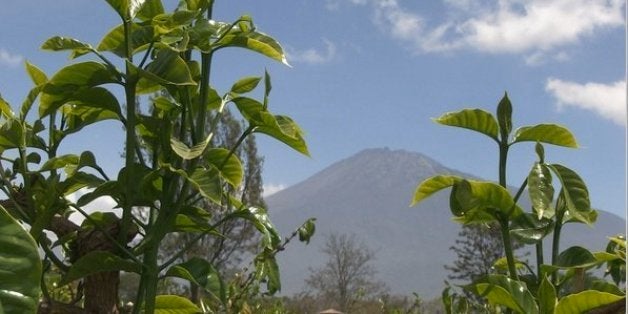
After tasting coffees (at the source) in over two dozen nations around the world, I think I've finally discovered the secret to growing "The World's Best Coffee."
It's not that I'm obsessed with coffee -- I'm obsessed with experiences! Each time I've traveled through a coffee exporting country (there are 51 of them at my last count), I've made it a point to experience the coffee grown there. I've been drinking the world's most popular beverage direct from the source.
Upon completion of my Mt. Kilimanjaro climb in 2008, we celebrated our safe descent (which is in many ways is more painful than the ascent), with a cup of fresh Kilimanjaro coffee, grown and brewed on the slopes of Africa's tallest dormant volcanic cones.
It was the most incredibly smooth cup of black coffee I'd ever drank in my life from a styrofoam cup. I had to have more!
After being whisked off to the Kilimanjaro Airport my only hope of exporting some of this incredible coffee to my home in New York was to scour the shelves at JRO's tiny duty-free corner. The only selection not appearing as if it were packaged in a dissolvable bag was a short tin can of "TanCafe," Pure Coffee from Tanzania: The Land of Kilimanjaro (the faded side photos of an arrogant giraffe and a bemused leopard didn't instill confidence in the tin's contents).
Don't judge a tin of coffee by its poorly photographed wildlife! That tin contained the most amazing coffee of my life.
I began to hoard the contents, doling them out on a case-by-case basis, terrified of reaching the bottom of the tin. Who knew when I'd return to the Kilimanjaro Airport? In the meantime, I re-doubled my efforts to taste every nation's coffee at each opportunity.
1. Panama
Strong, intense, raw -- loved it's intensity, but missed sublime notes.
2. Venezuela
Pale, lacked body, but I appreciated that it was unobtrusive.
3. El Salvador
A seriously great coffee, grown on the sides of active volcanoes and seemed to extract their power.
4. Zambia
High doses of caffeine -- stayed awake all day.
5. Indonesia
You know that coffee you've heard about that is made from beans collected out of cat droppings (Kopi Luawak)... It's actually the droppings of an Asian palm civet (a tiny omnivorous adorable animal), which eat only the ripest of cherries and partially digest the outer coating of the bean. It's the world's most expensive coffee and it's worth every rupiah (when you acquire it from the source -- import taxes are a bitch). But I still missed my "TanCafe."
I returned to East Africa a few months ago...
As soon as I made my way back to Tanzania, I rushed to the Arusha Coffee Lodge. The following day on a tour of the Burka Estate, in the shadow of Mt. Meru (Tanzania's tallest active volcano) it came to me: It's the Volcano!
As my work progressed through East Africa, I felt as though I continued to make startling coffee discoveries: Organic home-grown coffees from the foot of Mt. Elgon in Uganda, coffees growing within sight of the Virunga volcanoes in Rwanda, and more deliciously smooth delights from duty-free at the Dar es Salaam Airport in Tanzania (move over "TanCafe," this wasn't just about Kilimanjaro anymore).
I felt like Angela Lansbury solving the 100th murder in Cabot Cove, putting all my bits of information together to discover the common denominator behind growing all my favorite coffees: Volcanoes and the Equator.
It wasn't just the volcanoes (they are a dime a dozen in the coffee producing world). Tanzania, Uganda, Rwanda, Indonesia, Southern Colombia -- they're all within spitting distance of the Equator and contain volcanic cones.
But why?
The volcanic soil makes perfect sense: Just as in the growing of wine grapes, the soil nurturing the coffee shrubs has great influence over the final product. The Equator feels less intuitive, but still makes some sense. The Equator is the only place on Earth that receives exactly the same amount of daylight, each and every day of the year. It's also meteorologically unique in that annual rainfall is very high and temperatures hardly vary.
So that's it, my coffee quest had answers, and dozens of delicious brews to enjoy (with more to discover).
If you love coffee, world travel is an exceptional way to explore that passion. Get out there and go on your own coffee quest!
